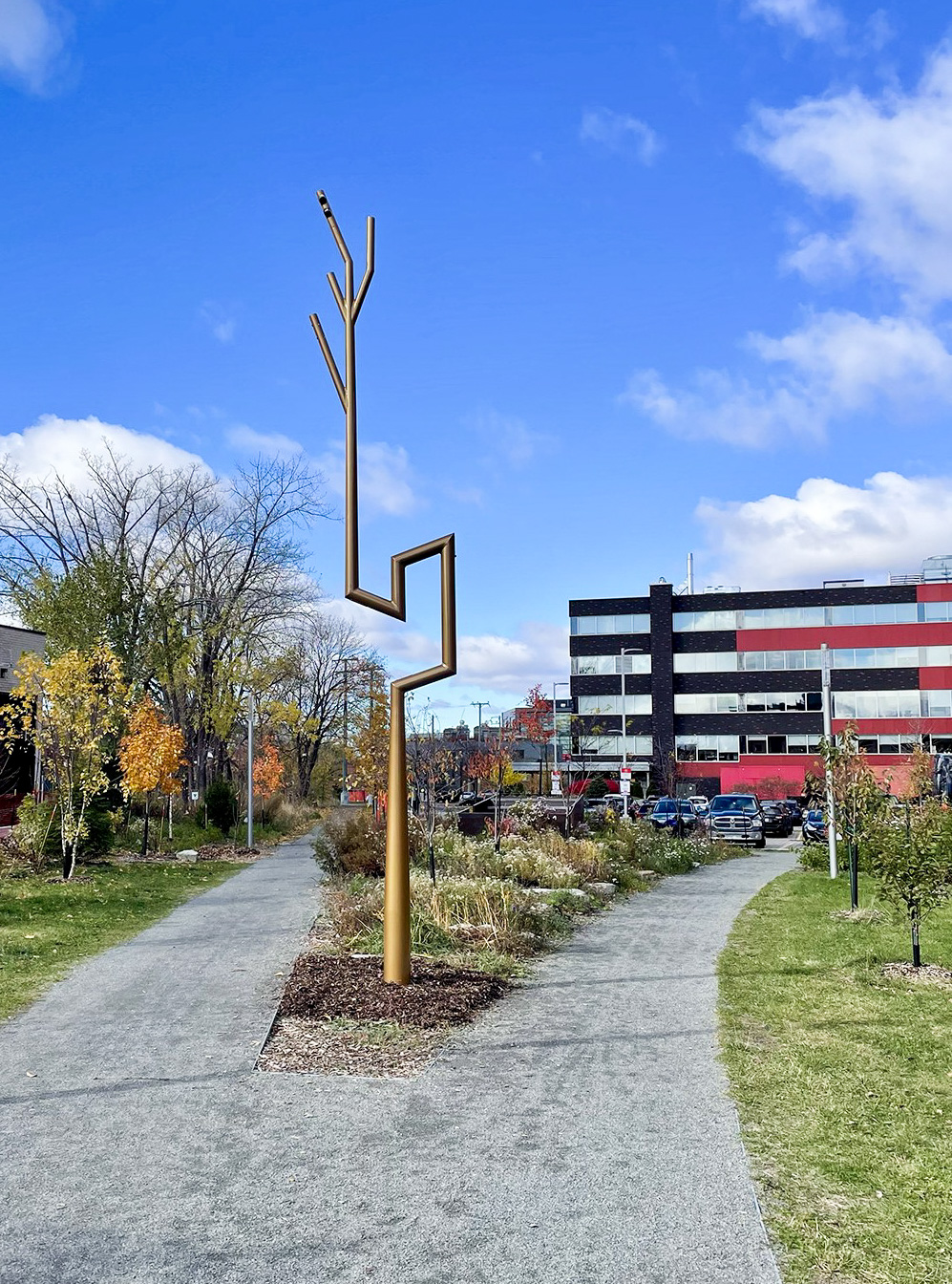Natacha Clitandre, Salima Punjani
Les embranchements fructueux
2025
Presentation of the artwork
Les embranchements fructueux is a three-part digital sculptural installation set along the trail that traverses Parc des Gorilles. Natacha Clitandre is responsible for the sculptural and visual design of the work, and Salima Punjani created the sound aspect. Inspired by the site’s history and the citizen mobilization connected to the park, the work gives voice to the AmiEs involved in preserving the empty lot. At both entrances to the park, interactive posts broadcast sounds and stories selected in collaboration with the AmiEs du parc. A mix of sewing-machine and train sounds, bird songs, and spoken words evoke the peaceful coexistence of the site’s different uses over time. The shapes of the tall sculptures were designed using L-Système, an algorithm that makes it possible to visually represent the growth of plants. Like the trees in the park, these sculptures bear witness to its wide variety of flora and to its rich arboreal and industrial history. The artists thank Olivier D. Asselin, Nathalie Barbeau, Martone Donde, Frances Foster, Mathilde Geromin, Trevor Goring, Erwan Jouault, Kae Loah, Maria Patricia Lucas, Alexandra Nadeau, Christian Scott and Simon Van Vliet for their contribution to the project.
Associated events
Integration of an artwork into Parc des Gorilles falls within the context of the transformation of an abandoned lot into an urban park. It is part of the major MIL Montréal project to requalify the public domain in the Marconi-Alexandra sector. Strong citizen mobilization, initiated in 2013, aimed at converting and developing the site following the illegal cutting of trees by the owner. The AmiEs du parc des Gorilles committee chose the park’s name to commemorate the struggle to preserve the lot. It also refers to the wild nature of the terrain, which resembled an urban jungle after the railway abandoned it.
Natacha Clitandre
Natacha Clitandre is a visual and digital artist, with degrees from UQAM (2000) and the Université Paris 8 (2007), who lives in Montréal. She scrutinizes our shared knowledge and spaces in order to uncover their various layers and historical scales. Her work has been shown in Europe and North America.
Salima Punjani
Salima Punjani lives and works in Montréal. A self-taught artist, she has a relational and multisensory practice. She engages our senses to facilitate the inclusion of people with disabilities and offers intimate, empathetic art experiences that encourage interconnection. Her works have been presented in Canada, Hungary, and Ethiopia.
Presentation of the artwork
Les embranchements fructueux is a three-part digital sculptural installation set along the trail that traverses Parc des Gorilles. Natacha Clitandre is responsible for the sculptural and visual design of the work, and Salima Punjani created the sound aspect. Inspired by the site’s history and the citizen mobilization connected to the park, the work gives voice to the AmiEs involved in preserving the empty lot. At both entrances to the park, interactive posts broadcast sounds and stories selected in collaboration with the AmiEs du parc. A mix of sewing-machine and train sounds, bird songs, and spoken words evoke the peaceful coexistence of the site’s different uses over time. The shapes of the tall sculptures were designed using L-Système, an algorithm that makes it possible to visually represent the growth of plants. Like the trees in the park, these sculptures bear witness to its wide variety of flora and to its rich arboreal and industrial history. The artists thank Olivier D. Asselin, Nathalie Barbeau, Martone Donde, Frances Foster, Mathilde Geromin, Trevor Goring, Erwan Jouault, Kae Loah, Maria Patricia Lucas, Alexandra Nadeau, Christian Scott and Simon Van Vliet for their contribution to the project.
Associated events
Integration of an artwork into Parc des Gorilles falls within the context of the transformation of an abandoned lot into an urban park. It is part of the major MIL Montréal project to requalify the public domain in the Marconi-Alexandra sector. Strong citizen mobilization, initiated in 2013, aimed at converting and developing the site following the illegal cutting of trees by the owner. The AmiEs du parc des Gorilles committee chose the park’s name to commemorate the struggle to preserve the lot. It also refers to the wild nature of the terrain, which resembled an urban jungle after the railway abandoned it.
Natacha Clitandre
Natacha Clitandre is a visual and digital artist, with degrees from UQAM (2000) and the Université Paris 8 (2007), who lives in Montréal. She scrutinizes our shared knowledge and spaces in order to uncover their various layers and historical scales. Her work has been shown in Europe and North America.
Salima Punjani
Salima Punjani lives and works in Montréal. A self-taught artist, she has a relational and multisensory practice. She engages our senses to facilitate the inclusion of people with disabilities and offers intimate, empathetic art experiences that encourage interconnection. Her works have been presented in Canada, Hungary, and Ethiopia.




